Jackass in military uniform
1941 year, the defense of Moscow.
“When I got there, I went down the wet steps to the dungeon of the command post.
- Ah, comrade Momysh-Ula, please come ...
It was a familiar hoarse voice.
I saw General Ivan Vasilyevich Panfilov.
- You, Comrade Momysh-Ula, could hear how we are today? - he squinted, he asked with a smile.
It is difficult to convey how pleasant at that moment was his calm, affable voice, his crafty squint. I suddenly felt not alone, not left alone with an enemy who knows something, a mystery of war unknown to me — a man who had never experienced a fight. It was thought: her, this secret, is also known by our general - the soldier of the last world war, and then, after the revolution, the commander of the battalion, regiment, division.
Panfilov continued:
“They beat it off ... Phew!” He caught his breath jokingly. - I was afraid. Just do not tell anyone, comrade Momysh-Ula. Tanks because they broke through ... Here he is, - Panfilov pointed to the adjutant, - was with me there, saw something. Well, say: how did you meet?
Jumping in, the adjutant happily said:
- They met us with a breast, comrade general.
Strange, steep kink, black panfilov eyebrows raised with displeasure.
- Breast? He asked. “No, sir, you can easily pierce your chest with any sharp thing, not just a bullet.” Eka said: breastfeed. Now entrust a company to such an eccentric in military uniform, and he will lead her to the tanks with her breast. Not breast, and fire! Guns met! Did not see what?
The adjutant hastened to agree. But Panfilov once again caustically repeated:
- Breast ... Go, see if they feed the horses ... And after half an hour they started to saddle.
The adjutant, waving, confusedly left.
- Young! - Panfilov said softly.
Looking at me, then at the captain unfamiliar to me, Panfilov drummed his fingers on the table.
“You can't fight breast infantry,” he said. - Especially, comrades, to us now. We have here, near Moscow, not a lot of troops ... We must take care of the soldier.
Thinking, he added:
“To protect not with words, but with action, fire.”
[Alexander Beck, Volokolamsk Highway, §2, One Hour with Panfilov].
1877-78 Russian-Turkish war.
Before the Russian-Turkish war, new rifles appeared in the armies of the world, which sharply increased the range and the probability of hitting the target. In addition, the new rifles were rapid. But in the Russian defense ministry, these innovations could not be assessed, according to the combat regulations, the combat formations of our troops remained closed and dense.
October 12 Our Life Guardsmen attacked Turkish redoubts near the villages of Gornij Dubnjak and Telish. The infantry regiments, according to the regulations, went on the attack “in battalion columns, in perfect order, as in a parade ... According to eyewitnesses, the commanders of the guards were walking at the head of their regiments with their balaclavas. Another - an eyewitness to the onset of the Izmailovsky regiment - wrote that "... the head companies were walking in an extended front, the officers in their places beat time:" Keep up! Left! Left! "[1877].
And the Turkish troops were already armed with new Winchester rapid-fire infantry rifles and Peabody-Martini rifles. And their artillery learned how to efficiently fire a canister.
Twice our Izmailovs, Finns, Pavlovians, Muscovites and arrows turned up to the attack, but the strong return fire from the Turks did not allow it to be successfully completed. The losses were heavy ... So, the Pavlovsky regiment (who started the attack) lost 400 lower ranks, Izmailovsky - 228 ... In the ranks of the attackers was the head of the 2-th Guards Division count Shuvalov. By the end of the battle, only two of the ranks of his staff remained in the ranks ... This is what the eyewitness recalled from the Russian side about this fight: "... fell in piles; without exaggeration, in two and a half - three arshins were heaps of wounded and killed ... [1]" .
From 9 o'clock in the morning to 5 o'clock in the evening, the Guardsmen followed the requirements of the outdated, not revised in time, charter. The total losses of those killed and wounded during the taking of the redoubt near the village of Gorny Dubnyak amounted to 3 general, 126 officers, 3410 lower ranks. Of these, 870 people were killed [1,2].
The village of Telish in the same ceremonial manner attacked the Leib-huntsman. Their attack was also repulsed, and the Egersky regiment lost 27 officers and 1300 of the lower ranks [1] of which nearly a thousand [2] were killed. The officer and artist Vasily Vereshchagin, who was a part of the Russian army, showed the results of these attacks in the film “The Defeated. Requiem for the fallen soldiers. "
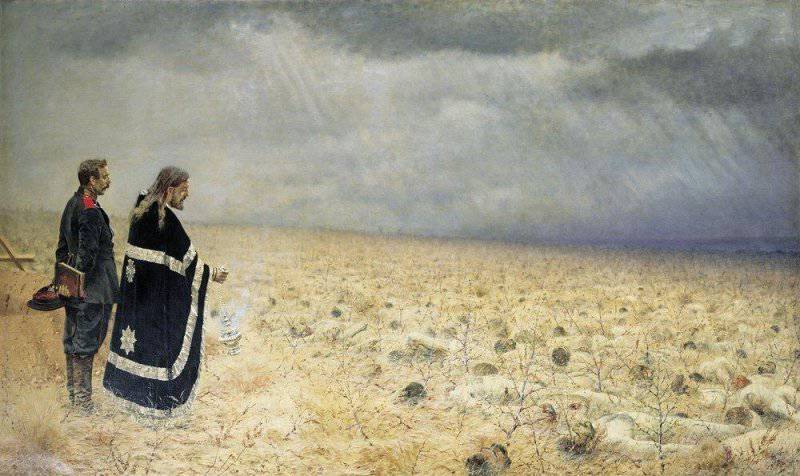
Redut near the village of Gorniy Dubnyak on October 12 was still possible. But not because "they filled up the enemy with corpses." Losses in general not only do not bring victory, but put it off: with our great losses, the enemy affirms his strength, becomes bolder and more stubborn. Redut Gorni Dubnyak was taken because they changed tactics. And the Guards sappers were the first to do this, since "they were poorly trained in the infantry battle formation." Here is what the eyewitness of this fight wrote:
"... Soon, Captain Pavlovsky, a regimental adjutant of the Grenadier Regiment's Life Guards, approached them and asked for help. The Guards grenadiers suffered heavy losses and are no longer able to move to the big Turk redoubt.
When two companies of guards sappers came to the edge of the forest, they saw a large mass of soldiers of the guard infantry lying between two Turkish redoubts under fire.
Lieutenant Rengarten turned his sapper into a rare chain and threw a small redoubt at a throw, being beyond the reach of artillery fire. Guards sappers quickly dug in, as the Turks began to fire at them with rifle fire. In this case, the company lost only two soldiers. It was about October 13-00 12 "[1].
By evening, the infantry pushed aside the ceremonial training, which led to losses and failures. Contrary to the requirements of the statute, having scattered on the ground in small groups, the infantry went on the attack, which was begun by the commander of the 2 Battalion of the Izmailovsky Regiment, Colonel Kshivitsky with three companies. One by one, in groups, from the shelter to the shelter, the guards sappers, Izmailovs, Muscovites, Pavlovians and Finns leaked onto the shaft and already in the dark with a cry of “Hurray!” broke into enemy trenches, where they entered into bayonet fighting. The Turks could not stand the melee and surrendered to the morning of October 13 [1].
“Mountaineer Dubnyak, in essence, was to be the last attack in the“ good old youth style ”, when at a fortified height, defended by an adversary armed with modern rapid-fire weapons, the best armies of the empire — the personal guard of the emperor — were thrown into a bayonet attack by closed ranks.
Due to the huge losses of the brilliant guard during the battle of local significance, Much Dubnyak was written and talked a lot after the Russian-Turkish war, but in practice they didn’t learn any lessons. In August, 1914 near the village of Zarashov, in June 1916 on the South-Western Front near the Stokhod River - the Guard repeated everything first ... For the last time ... "[1].
Do not be embarrassed by the fact that we are talking about a company and a battalion in the book of Viktor Nekrasov, and the number of personnel is like in a squad and platoon: it's just not their first battle.
“Major sniffles pipe. Coughs.
- Not a damn thing suppressed ... Not a damn ...
Abrosimov calls in the second, in the third battalion. Same picture. Zalegli. Machine guns and mortars do not give the head to raise. The major departs from the embrasure. His face is somehow swollen, tired.
- One and a half hours rumbled, and do not take ... survivors, devils. Kerzhentsev, the major says very quietly. - Nothing you do here. Go to your former battalion. To Shiryaev. Help ... - And, snoring a pipe: - There you have the Germans still dug the message. Shiryaev invented how to capture them. Put machine guns and pitch them in the flank. In the forehead, we still will not take.
- Take! - Abrosimov screaming unnaturally somehow - And we'll take it in the forehead, if we don't hide in the pits. ... Fire, you see, strong, does not allow to rise.
Usually his calm, cold eyes are now round and bloodshot. The lip is all trembling.
- Raise them, raise! Stale!
“But you do not boil, Abrosimov,” says the major calmly, and he waves his hand to me, go, they say.
...
Half an hour later, everything is ready at Shiryaev. In three places our trenches are connected with the German ones - on a hill in two and in a ravine. Each of them has two mined dam. At night, Shiryayev, with attached sappers, extended detonating cords to them. Trenches from us to the Germans checked, shot about a dozen minutes.
Everything is good. Shiryaev slaps his knee.
- Thirteen Gavrikov crawled back. We live! Let them rest for now, watch out. The rest of the ten people on the passage empty. Not so bad. BUT?
His eyes sparkle. A hat, shaggy, white, on one ear, hair stuck to his forehead.
...
We are standing in a trench at the entrance to the dugout. Shiryaev's eyes suddenly squint, his nose wrinkles. Grabs my hand.
- Fir-stick ... Climbs already.
- Who?
Across the ravine, clutching at the bushes, Abrosimov clambers. Behind him is connected.
Abrosimov shouts from afar:
- What the hell did I send you here? Lyasy sharpen, or what?
Out of breath, unbuttoned, there is foam in the corners of the mouth, eyes round, ready to jump out.
- I ask you - do you think whether to fight or not, your mother ...
“We think,” Shiryaev calmly replies.
- Then fight, damn you take ...
“Allow me to explain,” everything is just as calm, restrained, only the nostrils are trembling, says Shiryaev. Abrosimov reddens:
- I'll explain those ... - Grabs the holster. - Step march to attack!
I feel something boiling in me. Shiryaev breathes heavily, bowing his head. Fists clenched.
- Step march to attack! Have you heard? I will not repeat again!
He has a gun in his hands. The fingers are completely white. No bloodshed.
“I will not go to any attack until you listen to me,” gritting his teeth and uttering terribly slowly uttering every word, says Shiryaev.
For a few seconds they look into each other's eyes. Now they mate. Never have I seen Abrosimov like that.
- Major ordered me to seize those out trenches. I agreed with him ...
“They don't agree in the army, but carry out orders,” interrupts Abrosimov. “What did I order you in the morning?”
- Kerzhentsev has just confirmed to me ...
“What did I order you in the morning?”
- Attack.
- Where is your attack?
- I choked, because ...
“I don’t ask why ...” And, suddenly angry, he waves a pistol in the air. - Step march to attack! Shoot like cowards! Order not to perform! ..
It seems to me that he will fall down and be convulsed.
- All commanders ahead! And go ahead yourself! I will show you how to save my own skin ... Some trenches were invented by myself. Three hours as an order given ...
...
Machine guns put us almost immediately. The fighter running next to me falls down at once, flat, with his arms spread wide in front of him. I start up a fresh, still-smelling, crater funnel. Someone jumps over me. Sprinkle with earth. Also falling. Quickly going over and over, crawling somewhere to the side. Bullets whistle above the ground, hit the sand, squeal. Somewhere near a mine is torn.
I lay on my side, curled up in a ball, my legs tucked up to my chin.
No one shouts "Hurray!"
German machine guns are not silent for a second. It is quite clearly possible to disassemble how a machine-gunner turns a machine-gun - like a fan - from right to left, from left to right.
I cling to the ground with all my might. The funnel is quite large, but in my opinion, the left shoulder still looks out. Hands digging the ground. From the gap it is soft, gives in quite easily. But this is only the top layer, clay will go on. I frantically, like a dog, scrub the ground.
Tr-rah! Mine. I just sprinkle the earth.
Tr-rah! The second. Then the third, fourth. I close my eyes and stop digging. They noticed, probably, as I was throwing out the ground.
I lay there with bated breath ... Nearby someone groans: "Aaaaaa ..." Nothing more, just "aaaaaa ...". Evenly, without any intonation, on one note. ...
The machine gun starts firing intermittently, but still low, just above the ground. I absolutely can not understand why I am intact - not injured, not killed. Fifty meters to climb a machine gun - sure death. ...
The wounded man still groans. Without a break, but quieter.
The Germans carry the fire into the depths of defense. Breaks are heard already far behind. Bullets fly much higher. We decided to leave alone. ...
I make a small roller out of the ground in the direction of the Germans. Now we can circle back and look, I do not see it.
The fighter who ran beside me still stretches out his arms. His face is turned towards me. Eyes open. It seems that he put his ear to the ground and listens to something. A few steps from him - the other. Only legs in thick cloth windings and yellow boots are visible.
I count fourteen corpses altogether. Some, probably, from the morning attack remained. ...
Wounded all moans. He lies a few steps from my funnel, prone, head to me. Cap next. Hair black, curly, terribly familiar. Arms bent, pressed to the body. He crawls. Slowly, slowly crawling, not raising the head. Alone on the elbows crawling. Legs dragging helplessly. And all the while groaning. Quite quiet already.
I do not take my eyes off him. I do not know how to help him. I don't even have an individual package with me.
He is very close. Hand can reach.
- Come on, come here, - I whisper and stretch my hand.
The head is rising. Black, big eyes, already covered by the death thunder. Kharlamov ... My former chief of staff ... Looks and won't find out. On the face no suffering. Some kind of dullness. Forehead, cheeks, teeth in the ground. The mouth is ajar. The lips are white.
- Come on, come on here ...
Resting his elbows on the ground, he crawls to the funnel itself. Stuck his face into the ground. I put my hands under his arms, dragging him into the funnel. He is all kind of soft, boneless. Knocks head first. Feet completely lifeless.
With difficulty I stack it. Two closely in the funnel. I have to put his legs on his. He lies, his head thrown back, looking at the sky. Hard and rarely breathes. The gymnast and the upper part of the pants in the blood. I unzip his belt. Raise my shirt. Two small neat holes in the right side of the abdomen. I understand that he will die. ...
So we are lying - I and Kharlamov, cold, sprawling, with snowflakes in their hands. Clock stopped. I can not determine how much time we lie. Feet and arms go numb. Again seizes cramp. How much can you lie like that? Maybe just jump and run? Thirty meters - five seconds, at most, until the machine gunner remembers. Thirteen people ran out in the morning.
In the neighboring funnel, someone tosses. Against the background of white snow that is beginning to melt, a gray patch of earflaps is stirring. A head appears for a second. Hiding. Shown again. Then suddenly a man immediately jumps out of the funnel and runs. Quickly, quickly, pressing his hands to the sides, bent over, throwing his legs high.
He runs three-quarters of the way. There are some eight to ten meters to the trenches. His mowing machine gun. He takes a few more steps and falls straight forward with his head. So it remains to lie in three steps from our trenches. For some time, the overcoat darkens in the snow, and then it turns white. Snow is coming and coming ...
Then three more run. Almost all three at once. One in a short sweatshirt. The overcoat must have thrown off to make it easier to run. Kills him almost on the parapet. The second is a few steps away. The third manages to jump into the trench. On the German side, the machine gun for a long time puts a bullet after a bullet in the place where the fighter disappeared. ...
A small lump of clay strikes me in the ear. I shudder. The second falls near, near the knee. Someone throws at me. I raise my head. From a neighboring crater looks cheeked, unshaven face. ...
- Let's run. - Also could not resist.
“Come on,” I reply.
We go for a little trick. The previous three killed almost at the parapet. It is necessary, without reaching our trenches, to fall. By the time of the queue we will lie. Then with one jerk straight into the trenches. Maybe lucky.
- Go!
- Gone.
Snow ... Funnel ... Killed ... Snow again ... Falling onto the ground. And almost immediately: "Ta-ta-ta-ta-ta-ta ..."
- alive?
- Alive.
Lying face in the snow. Hands spread out. Left leg under the belly. It will be easier to jump up. There are five steps to the trenches or six. Out of the corner of my eye I devour this piece of land.
We must wait a minute or two to calm the machine gunner. Now he will not fall into us, we are too low.
You can hear someone walking in the trenches, talking. Words are not heard.
- Well - it's time.
“Get ready,” I say, not lifting my head into the snow.
“Yes,” replies on the left.
I'm all tense. In temples knocks.
- Come on!
Pushing off Three jumps and - in a trench.
We sit for a long time later, right in the dirt, at the bottom of the trench and laugh. Someone gives a cigarette butt. ...
In all, the battalion lost twenty-six people, almost half, not counting the wounded. ...
...
I'm late for the trial. I come when the major is already speaking. In the tube of the second battalion, this is the most spacious room on our site — it's so full of smoke that there are almost no faces. Abrosimov sits at the wall. The lips are compressed, white, dry. Eyes - in the wall. ...
Turning his head, the major looks at Abrosimov with a long, heavy look.
- I know that I am guilty. I am responsible for the people, not the chief of staff. And for this operation I am responsible. And when the divisional commander shouted at Abrosimov today, I knew that he was screaming at me. And he is right. - The Major runs his hand through his hair, gives us a tired look. - There is no war without casualties. That's the war. But what happened in the second battalion yesterday is no longer a war. This is extermination. Abrosimov exceeded his power. He canceled my order. And canceled twice. In the morning - by phone, and then myself, driving people to the attack.
“It was ordered to attack the tanks ...” Abrosimov interrupts with a dry, wooden voice, without taking his eyes off the wall. - And the people did not go on the attack ...
- You're lying! - The Major punches the table so that the spoon in the glass rattles. But then he restrains himself. Sips tea from a glass. - People went on the attack. But not the way you wanted it. People walked headlong. What did you do? Did you see what the first attack led to? But there could not be otherwise. We were counting on artillery preparation. It was necessary immediately, without letting the enemy recover, to hit him. And it did not work out ... The enemy turned out to be stronger and more cunning than we thought. We were unable to suppress his firing points. I sent an engineer to the second battalion. There was Shiryaev - a guy with a head. From the night he was still preparing everything to capture the German trenches. And cleverly prepared. And you ... And what did Abrosimov do? ...
They say a few more people. Then I. For me - Abrosimov. He is brief. He believes that the tanks could be taken only by a massive attack. That's all. And he demanded that this attack be carried out. Combat cherish people, so do not like attacks. Buck could only take an attack. And he is not guilty that people in bad faith reacted to this, chickened out.
- chickened out? .. - is heard from somewhere in the depths of the pipe.
All turn around. Awkward, head and shoulders above all those around him, in his short, ridiculous little overcoat, squeezes himself towards Farber's desk.
- chickened out, you say? Shiryaev chickened out? Karnaukhov chickened out? Are you talking about them?
Farber gasps, blinks with short-sighted eyes - he smashed his glasses yesterday, squinting.
“I saw everything ... I saw it with my own eyes ... How Shiryaev walked ... And Karnaukhov, and ... everything went as it is ... I can't speak ... I know them recently ... Karnaukhov and others ... As you only turn your tongue. Bravery is not about to climb with a bare chest on a machine gun. Abrosimov ... Captain Abrosimov said that it was ordered to attack the tanks. Not to attack, but to master. The trenches invented by Shiryayev are not cowardice. This is a reception. The correct reception. He would save people. Saved so that they could fight. Now they are not. And I think ... - His voice breaks down, he is looking for a glass, he does not find, waves his hand. - I think such people cannot be, they cannot be commanded ...
Farber finds no words, goes astray, blushes, looks for glass again, and suddenly he immediately blurts out:
- You yourself are a coward! You did not go on the attack! And they kept me still. I saw everything ... - And, having twitched his shoulder, clinging with the hooks of the overcoat to the neighbors, he squeezes back. ...
...
In the evening comes Lisagor. Slam the door. Peeps into the pan. Stops near me.
- Well? - I ask.
- Demoted and - in the penalty area.
We don’t speak about Abrosimov anymore. The next day he leaves, without saying goodbye to anyone, with a bag over his shoulders.
I never saw him again and never heard of him. ”
[Victor Nekrasov, "In the trenches of Stalingrad"].
"The so-called tactics of actions used by Iraqis, as if" taken from Soviet textbooks of the Second World War era, were surprisingly surprising. In their case, the Iraqi generals, in the opinion of the emerging favorable conditions, threw their infantry into a frontal attack under the destruction of all powerful living fire of American means of destruction [3].
Note that Iraq lost the war with an incredible loss ratio - according to various estimates, from 75: 1 (lost 150 thousand killed) to 300: 1 (lost more than 600 thousand killed) against about 2 thousand losses of the Americans and their allies.
“The modern dynamics of close combat requires a high combat rate of fire on massive, high-speed targets, therefore modern AK-74 (AKM) automatic rifles are fired from the constant“ P ”sight ...”
[Conclusion FGKU "3 Central Research Institute" of the Ministry of Defense of Russia, ref. No.3 / 3 / 432 from 08.02.2013].
Since the battles near the villages of Gorny Dubnyak and Telish, 125 years have passed, the destructiveness of the “massive attack” has not yet been proven in blood. In foreign armies, such tactics have long caused only amazement, it is considered “complete insanity and self-destructive fanaticism that does not bring any benefit in battle” [3] and their combat regulations are not provided for. But, as we see, our Ministry of Defense invented a convenient enemy for itself, who is still attacking with a "massive, high-speed" crowd under our automatic fire.
And if this invented enemy still has to lie down, then he is not hiding behind any parapet, but always lies down in an open place so that he can be quickly killed. Our Ministry of Defense is so confident in this that the sights of Kalashnikov’s machine guns and machine guns of all models, as well as instructions (guides) on them, are optimized for a direct shot at targets with a height of 0,5. The target with a height of 0,5 m (chest target) simulates an arrow lying on a level place and shooting with elbows set shoulder-width apart. The position “P” of the sight of our automatic rifles is equal to the range of a direct shot precisely at the chest target.
The Russian Defense Ministry has assigned a pectoral target to the machine gun, and does not want to know anything else:
"The main targets hit from the machine are targets similar in size to the height and chest (and not the head) figure of a soldier."
[Conclusion FGKU "3 Central Research Institute" of the Ministry of Defense of Russia, ref. No.3 / 3 / 432 from 08.02.2013].
But common sense, stories of veterans, photographic documents suggest the opposite: each fighter seeks to hide behind the parapet. Whether created, natural, just to hide. Therefore, in combat, there are mostly head targets.
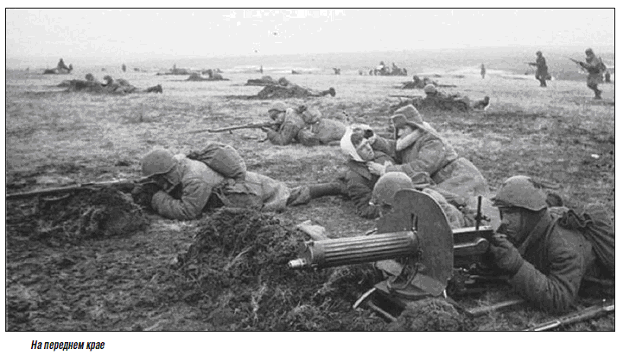
And the shooter behind the parapet is not a chest target, but a head target (the height of the whole 0,3 m).
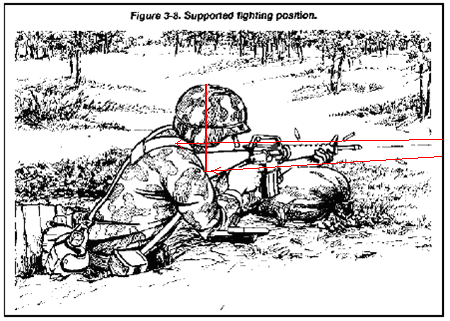
And when our submachine gunners with a sight for the chest figure shoot at a lower head, then at distances from 150 m to 300 m, the average trajectory of bullets goes above the target. Because of this, the probability of hitting the head - the most common and most dangerous (it is she firing) - the target is extremely small: it drops to 0,19 [4].
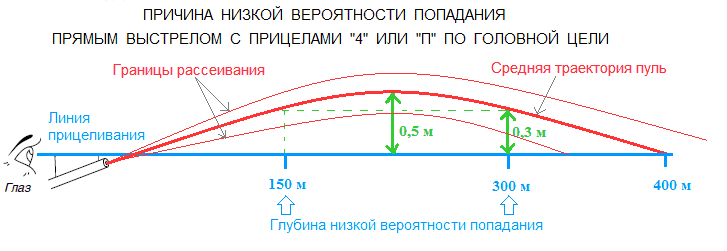
Since our submachine gunners practically cannot reach the head target, these targets in our “Shooting Course” only a sniper learns to hit - one barrel from the entire branch. But SVD alone cannot win a fight. The machine gunners must and, most importantly, are likely to hit head targets if the AK-74 is to be fired with a direct shot not with the “P” or “4” sight, but with the “3” sight. Then the probability of hitting each machine gunner in the most common goal in battle - the head one - will increase on average 2 times, and at a distance of 250 m - 4 times! If we take into account the number of automatic weapons in the armed forces, then the significance of such a change in the firing of an automaton can be compared with the significance of tactical nuclear weapons.
All of the above, I proved in the work "The submachine gun must and can hit the head figure." The work was published by the Academy of Military Sciences in its edition “Vestnik AVN” No. 2 for 2013, the updated version of the work is posted on the Academy's scientific forum site: www.avnrf.ru (http://www.avnrf.ru/index.php/forum / 5-nauchnye-voprosy / 746-avtomatchik-dolzhen-i-mozhet-porazhat-golovnuyu-tsel # 746).
And I re-sent my proposals, already supported by this work, to the Ministry of Defense. The answer came from the commander of the military unit 64176 (Main Rocket and Artillery Directorate):
“The analysis of the materials presented by you with the involvement of specialists from FSUE“ 3 Central Research Institute of the Ministry of Defense of the Russian Federation ”showed the following:
1. The proposals set forth in the materials “The machine gunner should and can hit the head figure” are of no interest to the Ministry of Defense of the Russian Federation. ... I recommend you to contact the FSUE “TsNIITOCHMASH”, Klimovsk, for an independent opinion.
[Ex. No. 561 / 7467 from 16.10.2013].
The media is discussing a competition for a new machine. The tests are AEK-971, in which the dispersion of shots in 1,5 times less than the AK-74. The developers of the other tested automaton - AK-12 - also declare the small dispersion of their offspring. It is understood that a small dispersion of shots (bullets) is good.
However, small dispersion is good only when the average trajectory of shots did not go beyond the contours of the target. Then, narrowing the sheaf of trajectories, more bullets are sent to the target and fewer bullets go beyond the dimensions of the target. The likelihood of hitting is growing.
If the average trajectory of the shots is beyond the contours of the target, then reducing the dispersion (narrowing the sheaf of dispersion) leads to the fact that more bullets go past the target, and less bullets hit the target. Chance to hit is reduced.
As shown in Figure 4, with a direct shot with “4” or “P” sights at distances from 150 m to 300 m, the average trajectory is above the head target. This means that if the “P” sight on the chest target remains on the new machine, then the combat (on the head target) effectiveness of firing the new machine will be significantly worse than the AK-74.
If we adopt a new assault rifle with a “P” sight on the pectoral target, then we will get an even lower probability of hitting the most common and most dangerous target in battle - the head one.
The output is elementary: on the new machine gun, the “P” sight must be made appropriate to the range of a direct shot at the head target - around 350 m. Then the average trajectory of the shots will not rise above the upper edge of the head target, remain in the contours of the target. And because the smaller dispersion of the new machine gun really will significantly increase its combat effectiveness.
I indicated all this in my appeal to FSUE TsNIITOCHMASH, and, as recommended by Grau, I sent an appeal to Klimovsk.
Conclusion TSNIITOCHMASH says (out. No. 597 / 24 from 05.02.2014):
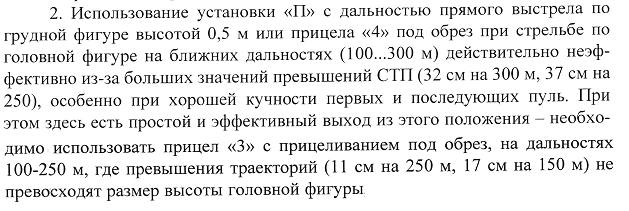
Why, this is exactly what I have been offering for more than a year! So what? Now, scientists from TsNIITOCHMASH will propose to change the method of firing at AK-74, and do the developed machine gun recommend to immediately install the “P” sight of the appropriate range of a direct shot at the head target? No, scientists from TsNIITOCHMASH are not like this:
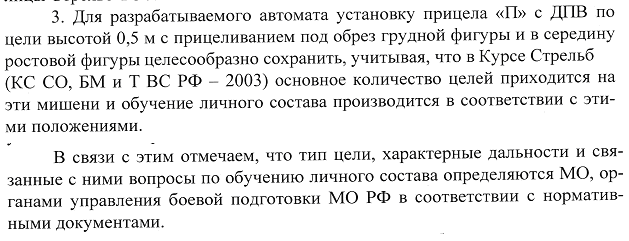
This means that the new machine gun is being developed not for combat, but for a shooting range where the target situation does not correspond to the battle.
So, since the fighting near the villages of Gorny Dubnyak and Telish, 125 years have passed, and the destructiveness of the “massive attack” has been proven more than once in blood. All our probable opponents have been fighting for a long time in dispersed orders, necessarily hiding behind the parapet.
But the people currently occupying responsible posts in our Ministry of Defense are still preparing to fight only with a “massive, speedy goal” and do not want to hear anything about the need for the machine gunner (by the way, the machine gunner too) to hit a low target. And scientists from the 3 Central Research Institute of the Ministry of Defense and from TsNIITOCHMASH are not worried about what a soldier needs in a battle, but about how not to cause anxiety to officials from the Ministry of Defense. But you have to redo the regulatory documents!
For some reason, I am sure that General Ivan Vasilyevich Panfilov would call such officials of the Ministry of Defense, and such military scientists, “eccentrics in military uniform”!
References:
[1] "The assault of Mountain Dubnyak 12-13 October 1877 of the year." Ladygin I.V., Anatomy of the Army website, http://army.armor.kiev.ua/.
[2] “Gambit on the Sofia highway (October 12 1877). Part II. Shikanov V.N., the site of the Military-Historical Club “Fatherland”, the Life-Grenadier Regiment, http://leibgrenader.clan.su/.
[3] "Pyrrhic victory of the American troops." Pechurov S., site http://nvo.ng.ru/, 09.11.2013.
[4] "The submachine gun must and can hit the head piece." V. Svateev, “Bulletin of the Academy of Military Sciences” No. 2 for 2013, the updated version is available on the website of the Academy of Military Sciences at: http://www.avnrf.ru/index.php/forum/5-nauchnye- voprosy / 746-avtomatchik-dolzhen-i-mozhet-porazhat-golovnuyu-tsel # 746.
Information